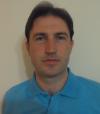What Does This ECG Report Indicate?

 Thu, 31 Dec 2015
Answered on
Thu, 31 Dec 2015
Answered on
 Sat, 23 Jan 2016
Last reviewed on
Sat, 23 Jan 2016
Last reviewed on
I would explain as follows:
Detailed Answer:
Hello.
Welcome an thank you for asking on HCM!
I reviewed your ECG and would like to explain that it has the pattern of right bundle branch conduction delay (QR in V1-V2).
Also it is seen increased QRS amplitude in mid-precordial leads.
At this point a correlation with the clinical background is necessary, as a differential diagnosis including hypertrophic cardiomyopathy, left septal fascicular block, a chronic pulmonary disorder, and even an ischemic cardiac disorder.
If you are clinically normal (no chest pain, no pulmonary function exacerbation, no systolic murmur during cardiac auscultation) then nothing to worry about the intervention you have planned.
No cardiac contraindication seems to be obvious regarding your knee arthroscopy.
I recommend you discussing with your cardiologist to see the possibility of performing a cardiac ultrasound (ECHO) for the differential diagnosis.
After the preliminary investigation (physical exam and ECHO), also a chest X ray study and eventual exercise stress test (if coronary risk factors like hypertension, diabetes, smoking, dyslipidemia, etc. are present).
I hope you a successful proceeding with your programmed procedure.
I remain at your disposal for further discussion in case you have other uncertainties.
Wishing you all the best for the New Year!
Kind regards,
Dr. Iliri

Opinion as follows:
Detailed Answer:
Hi again,
Clinical correlation means to find ECG pattern explanations by taking into account previous known health disorders (such as I mentioned above: pulmonary disorders, possible hypertrophic cardiomyopathy, ischemic cardiac disorder, etc.
Such ECH changes are usually found in each of these pathologies.
As your ECG patters I mentioned above are not specific for a certain problem, it is necessary to perform a differential diagnosis by excluding one by one possible causes.
As you are a healthy active person, then probably those ECG changes mean nothing, but to be sure of that i recommend you to follow the above mentioned diagnostic strategy.
So, a careful cardiac physical exam and a cardiac ECHO, to assure you have no structural heart disease.
Cardiac stress test would be necessary only if you have recently experienced suspicious chest pain/discomfort, especially if you have know coronary artery risk factors (as I mentioned above, hypertension, smoking, glucose metabolism disorders or diabetes, dyslipidemia, etc).
You are right about right bundle branch block. Judging from your perfect physical well-being, those ECG patterns probably mean nothing abnormal.
Just to be sure of this conclusion, I recommended the above mentioned diagnostic path.
Best wishes!
Dr. Iliri

I would explain:
Detailed Answer:
Hi,
You are right about incomplete bundle branch block.
But, regarding your QRS duration, I would explain that 94 ms is an average value drawn by the ECG device, but if we take into account the dispersion in duration (that frequently exist between several ECG leads), I could say that in leads V1-V2 (reflecting right ventricle) QRS duration is greater (almost 3 small boxes).
Remember 1 small ECG box is equivalent to 40 ms.
Also increased QRS amplitude in mid-precordial leads and signs of left septal fascicular block (absence of q wave in V5-V6 and appearance in V2).
As I explained you above, a differential diagnosis between several alternatives should be done, because ECG test not rarely lacks sufficient specificity to conclude a certain problem.
This is your case.
That's why I recommended you the above diagnostic workup.
Regarding hypertension, I could explain that though you have controlled your BP values by taking medications, it is considered theoretically a coronary risk factor (but not as harmful as if left untreated).
About medical tests, I could advice you about having a cardiac ECHO first and chest X ray study.
If certain problems are concluded by medical review (physical exam, tests) additional tests would be necessary accordingly.
To conclude, your ECG doesn't pose any risks for your programmed procedure.
Regards,
Dr. Iliri
Answered by

Get personalised answers from verified doctor in minutes across 80+ specialties



